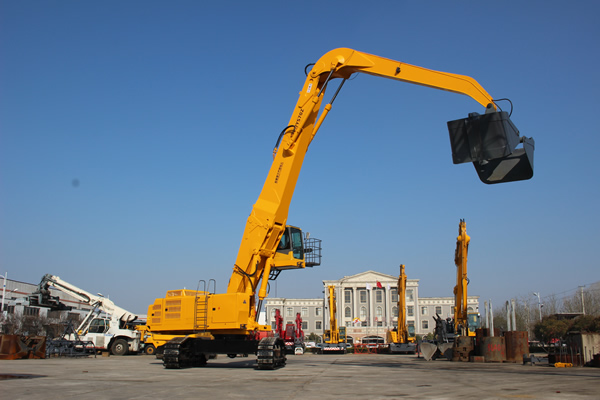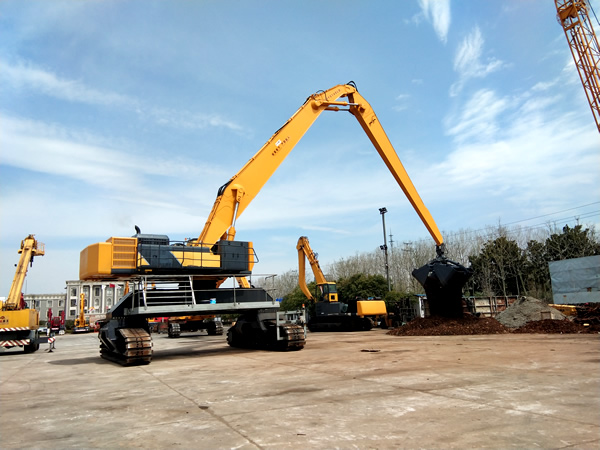What are the facilities and equipment of the port?
1、 Port logistics infrastructure:
Port logistics infrastructure refers to the facilities that must be provided to complete the most basic functions of port logistics. It generally includes port channel, breakwater, anchorage, wharf, berth, port traffic and supporting facilities.
1). Port channel: refers to the channel with sufficient water depth and certain width in the port to ensure the safe and convenient access of ships to and from the port and berthing and departing from the wharf. It can be natural or manually excavated.
2). Breakwater: a hydraulic structure located outside the port waters to resist wind and waves and ensure a stable water surface in the port. It is mainly used to meet the requirements of stable water surface and safe and convenient navigation in and out of the port when ships are berthed in the port and loading and unloading operations are carried out.
3). Anchorage refers to the waters in the port for safe berthing, shelter from wind, customs border inspection, quarantine, cargo loading and unloading, and barge passing and marshalling operations. It is also called anchorage and berth. The water area used as the anchorage shall have proper water depth, mud or sand as the bottom material, and sufficient anchorage (the position required for berthing a ship), so as not to hinder the normal navigation of other ships.
4). Wharf: a hydraulic structure for ships to dock, load and unload goods and get on and off tourists. Broadly speaking, it also includes warehouses, storage yards, loading and unloading equipment, railways, roads, etc. The wharf is the main part of the port. The wharfs can be divided into freight terminals and passenger terminals according to their purposes. The freight terminals are divided into general cargo terminals and professional terminals. The general cargo wharf is used for loading and unloading various kinds of general cargo, and the loading and unloading machinery equipped is of great versatility. The professional wharf is equipped with efficient special machinery and equipment. Bulk cargo with large handling capacity and stable flow, such as oil wharf, coal wharf, ore wharf, etc. The container terminal built with the development of waterway container transportation is also a special terminal. The container terminal is equipped with quayside container cranes and other special machinery, as well as a wide storage yard and a unpacking and packing warehouse.
5). Berth: refers to the length of shoreline occupied by a designed standard ship type dock or the number of stowed ships occupied. The berth length generally includes the length L of the ship and the necessary safety interval d between ships. The value of d varies according to the size of the ship, and a 10000 tonnage berth is 15-20 meters. The purpose of the berth is to load and unload goods specially. The number and size of berths are important signs to measure the scale of a port or wharf. A wharf may consist of one or several berths, depending on its layout and location.
6). Port traffic and supporting facilities: mainly including port roads, port railways and port power supply.
The port roads are the access roads in the port for the operation of mobile machinery and connected with urban roads and port dredging roads. The roads in the port are generally arranged in a circular way to facilitate the passage of transport vehicles and minimize the crossing with the railway line or interference with loading and unloading operations. The railway in the port is a railway transportation line laid inside the port area. Including lines, locomotives, communications, signals and other buildings and equipment related to railway transportation. Port railway is the main mode of collection, distribution and transshipment in many ports. The perfect port railway system is generally equipped with port stations, district stations, wharfs and loading and unloading lines of the warehouse, as well as the main line, connecting line and connecting line of the port railway section connecting these parts into a whole. The layout of the railway in the port area shall follow the following principles: short and fast lines, compact layout, the transportation capacity of the lines shall adapt to each loading and unloading link of the port, and certain room for development shall be reserved. Power supply in the port area is a power supply facility set up to meet the power required by the power, lighting and communication equipment of the port, and is an important supporting facility in the port area.
2、 Operational facilities of the port:
The operational facilities of a port refer to the facilities of the port terminal that provide cargo handling, storage and other production and operation and related services, mainly including loading and unloading production facilities and cargo storage facilities. According to international and domestic practices, these facilities are usually added and operated by port operators.
1). Loading and unloading facilities. Loading and unloading facilities mainly refer to the loading and unloading and handling machinery used by the port for ships and vehicles to load and unload goods and for cargo handling in the port area. The type and quantity of port loading and unloading machinery shall be determined according to the type of cargo to be loaded and unloaded, handling capacity and loading and unloading technology. Port loading and unloading machinery and equipment is an important part of the port system, which can be divided into lifting machinery, carriers, conveying machinery and various special machinery for loading and unloading.
2). Port yard. The port warehouse is the general name of the warehouse, cargo shed and storage yard in the port area, which provides short-term storage for goods before loading and unloading. It is composed of warehouse and storage yard. The port warehouse is the main distribution place of goods, which plays the role of reserve, adjustment, sorting and buffering in the process of cargo handling and transshipment. The warehouse is mainly used to store goods that are not suitable for sunshine and rain and valuable goods that are easy to lose. It can be divided into front warehouse and rear warehouse. The front warehouse is used to store goods for a short time to speed up the turnover of vehicles, ships and goods; The goods can be stored in the rear warehouse for a long time to serve the purpose of the owner's storage and standby. The freight yard is mainly used to store goods that are not affected by rain, sun and temperature changes, such as coal, ore, sand, stone, brick and tile and other building materials. The goods shed refers to a storage yard with only the shed roof covered but no shelter on all sides, for temporary stacking of goods that are not suitable for sunshine and rain.
3、 Port equipment:
1). Lifting machinery
Hoisting machinery is mainly various cranes. Portal cranes, portal grab ship unloaders and bridge type grab are widely used in ports
Bucket unloaders, gantry cranes, floating cranes, etc. The container terminal mainly uses quayside container cranes.
①Portal crane
It is also called gantry crane or gantry crane because of its door shaped base (door base). This crane has a long boom and a large lifting height
The working speed of the mechanism is fast, so the working range is large, the productivity is high, and different picking devices can be equipped.
② Gate seat grab ship unloader
The special machinery derived from the portal crane, also known as the gantry crane with bucket, is mainly used for the unloading of bulk cargo at seaports. The structure is similar to that of the portal crane, but the portal is equipped with a hopper and belt conveyor system for bulk cargo, and the lifting appliance is a grab bucket.
After grabbing the bulk cargo from the cabin, the grab unloads the bulk cargo into the hopper on the portal seat through lifting and luffing, and then the bulk cargo is transported to the storage yard by the belt conveyor system.
③Bridge type grab ship unloader
Special ship unloading machinery for bulk cargo with high productivity. It is different from the portal grab ship unloader in that its horizontal moving grab
The bucket is realized by the grab trolley traveling on the crane bridge rail, not by the boom pitch.
④Quayside container crane
It is a special crane for container loading and unloading. It is arranged at the front of the container terminal, and its shape is similar to that of the bridge type grab ship unloader.
There are many types of quayside container cranes. At present, China adopts a portal frame composed of front and rear door frames and pull rods, and the portal frame follows the code
The head travels along the track, and the bridge is supported on the gantry.
⑤Gantry crane
Bridge crane with horizontal main beam supported on two rigid legs. The crane trolley travels on the track of the main beam. Gantry rise
There are two types of heavy machines: track type and tire type. The track type moves along the ground track, and the tire type moves flexibly. It is mainly used for loading and unloading and stacking containers in the storage yard.
⑥Floating crane
The boom crane installed on the flat bottom ship or special ship is also called floating crane or crane ship. Due to large lifting capacity and maneuverability
At the same time, it is not affected by water level changes, so it is widely used in loading and unloading operations in seaports and river ports.
2). Handling machinery
Loading and unloading machinery is a kind of machinery that can be used for horizontal handling and stacking of goods. It is used for loading, unloading and stacking of goods at ports
And short distance horizontal transportation of goods. The loading and unloading machinery mainly includes forklift, tractor, straddle carrier, carrier, trailer and flatbed truck.
① Fork truck
The loading and unloading handling machinery with lifting gantry and fork is installed in front of the tire chassis, which is referred to as forklift or forklift for short. It is widely used in docks, storage yards, cabins and vehicles. When working, the forklift will insert the fork into the pallet, and then lift the fork to lift the goods stacking operation.
② Straddle carrier
The handling machinery, which is composed of a portal frame, a lifting frame with a holding fork and a tire type traveling mechanism, is also called straddle vehicle. Generally
Driven by internal combustion engine. The straddle carrier is applicable to the handling and stacking of large and large cargoes, such as steel, wood and large boxes. Electric hoist, referred to as electric hoist for short, is a light and small lifting equipment. Most electric hoists are operated by people on the ground with buttons, or they can be operated in the cab or controlled by wired (wireless) remote control.
③High motorized large boom loader
In order to meet the requirements of loading and unloading 5000 tons of ship bulk materials at inland river terminals, Bada Heavy Industry has specially developed a 70-100 ton large dual power loader, with a boom length of 22 meters and an operating efficiency of 500-600 tons/hour. It is equipped with a dual power system of engines and motors, which is energy-saving and environmentally friendly, and its operating range reaches 18 meters.


